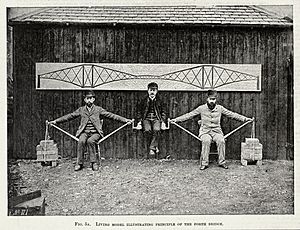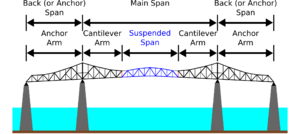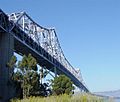Cantilever bridge facts for kids
A cantilever bridge is a special type of bridge that is supported only on one end. Imagine a diving board: it's held firmly at one end, and the other end sticks out over the water. That's how a cantilever works!
For small footbridges, the parts that stick out might be simple beams. But for big bridges that carry cars or trains, these parts are usually strong trusses made of structural steel, or hollow box girders made of prestressed concrete.
When steel truss cantilever bridges were first used, they were a huge step forward in engineering. They could stretch over very long distances, more than 1,500 feet (457 meters)! They are also easier to build over tricky spots, like deep rivers or canyons, because they don't need temporary supports underneath them during construction.
Contents
How Cantilever Bridges Began
In the 1800s, engineers learned that a bridge built on many supports could share the weight better. This meant less stress on each part of the bridge, allowing them to build longer spans. Some engineers designed bridges with special "hinge" points in the middle of their spans. These hinges helped engineers figure out the forces on the bridge more accurately. They also allowed the bridge to handle if its foundations settled unevenly.
Heinrich Gerber was an engineer who got a patent for a hinged beam in 1866. He is known for building the first modern cantilever bridge. This was the Hassfurt Bridge over the Main River in Germany, finished in 1867. Its main section was 124 feet (38 meters) long.
Other early cantilever bridges included the High Bridge of Kentucky (1877), the Niagara Cantilever Bridge (1883), and the Poughkeepsie Bridge (1889). The Kentucky River Bridge crossed a gorge 275 feet (84 meters) deep. Because it was a cantilever, it didn't need supports during its construction.
The most famous early cantilever bridge is the Forth Rail Bridge in Scotland. This amazing bridge held the record for the world's longest span for 17 years!

How Cantilever Bridges Work
A simple cantilever bridge has two arms that reach out from opposite sides of the gap they are crossing. These arms meet in the middle.
Sometimes, the cantilever arms don't meet. Instead, they support a separate, central truss bridge section. This is called a suspended span. This middle section can be built somewhere else and then lifted into place. Or, it can be built right there using special moving supports.
Many large cantilever bridges are built as balanced cantilevers. This means that for every part of the bridge reaching out over the gap, there's another part reaching in the opposite direction. If these opposite parts are firmly attached to strong foundations, they are called anchor arms.
For a bridge built on two main piers (supports), there are usually four cantilever arms. Two arms stretch over the obstacle, and two anchor arms extend away from the obstacle. Because the supports of a balanced cantilever need extra strength, the bridge often has tall towers above the main piers. The Commodore Barry Bridge is a good example of this type of cantilever bridge.
Steel truss cantilever bridges carry weight by having their top parts pulled tight (this is called tension). Their bottom parts are squeezed together (this is called compression). Usually, the pulling force (tension) is sent through the anchor arms to the very outer supports. The squeezing force (compression) goes down to the foundations under the central towers.
Prestressed concrete balanced cantilever bridges are often built in sections, like putting together a giant puzzle. This is called segmental construction.
Building Cantilever Bridges
Some steel arch bridges, like the Navajo Bridge, are actually built using cantilever methods from each side. The two halves are built outwards until they meet in the middle. They are then joined together, often by forcing the meeting point slightly apart before connecting them. Once the temporary tools are removed and the bridge deck is added, it becomes a truss arch bridge. This way of building without supports is only possible if there's strong rock to hold the top part of the bridge in place during construction. This usually limits this method to crossing narrow canyons.
Longest Cantilever Bridges
Here are some of the world's longest cantilever bridges, based on the length of their longest main section:
- Quebec Bridge (Quebec, Canada) – 1,800 feet (549 meters)
- Forth Bridge (Firth of Forth, Scotland) – two sections of 1,710 feet (521 meters) each
- Minato Bridge (Osaka, Japan) – 1,673 feet (510 meters)
- Commodore Barry Bridge (Chester, Pennsylvania, USA) – 1,644 feet (501 meters)
- Crescent City Connection (dual spans) (New Orleans, Louisiana, USA) – 1,575 feet (480 meters)
- Howrah Bridge (Kolkata, West Bengal, India) – 1,500 feet (457 meters)
- Veterans Memorial Bridge (Gramercy, Louisiana, USA) – 1,460 feet (445 meters)
- San Francisco – Oakland Bay Bridge (East Bay Span) (San Francisco, California, USA) – 1,400 feet (427 meters)
- Horace Wilkinson Bridge (Baton Rouge, Louisiana, USA) – 1,235 feet (376 meters)
- Tappan Zee Bridge (South Nyack, New York & Tarrytown, New York, USA) – 1,212 feet (369 meters)
Examples
-
The Quebec Bridge is a great example of this type of structure.
-
The Firth of Forth rail bridge has three double cantilevers.
-
The eastern span of the San Francisco–Oakland Bay Bridge.
Images for kids
-
The old eastern span of the San Francisco–Oakland Bay Bridge being taken apart in August 2014. It was taken apart almost in reverse order of how it was built.
-
The famous Howrah Bridge in Kolkata.
-
The Pulaski Skyway.
See also
 In Spanish: Puente en ménsula para niños
In Spanish: Puente en ménsula para niños









